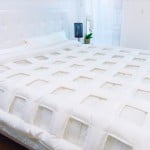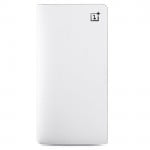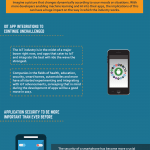![]() While PLA is by far the most popular filament type for desktop 3D printers, many companies that develop high-quality prototypes or end-use products have no choice but to turn to ABS because of its durability and high heat tolerances. Unfortunately, while ABS remains an extremely popular material for injection molding, it has several drawbacks that make it imperfect for 3D printing. The need for high printing temperatures often makes the material unsuitable to most desktop 3D printers. Additionally, because the material is made from styrene and other potentially toxic materials there are some health risks involved with repeated use of the material. Like most plastics, ABS is also not a biodegradable material, making products made from it a burden on our already over-taxed landfills.
While PLA is by far the most popular filament type for desktop 3D printers, many companies that develop high-quality prototypes or end-use products have no choice but to turn to ABS because of its durability and high heat tolerances. Unfortunately, while ABS remains an extremely popular material for injection molding, it has several drawbacks that make it imperfect for 3D printing. The need for high printing temperatures often makes the material unsuitable to most desktop 3D printers. Additionally, because the material is made from styrene and other potentially toxic materials there are some health risks involved with repeated use of the material. Like most plastics, ABS is also not a biodegradable material, making products made from it a burden on our already over-taxed landfills.
However many companies have been working on developing PLA-based 3D printing materials that offer all of the strength and heat resistance of ABS, without the list of drawbacks or need for industrial quality 3D printers. NatureWorks, a Florida-based biopolymer manufacturer that specializes in developing plastics using renewable, abundant green feedstock, has just announced a new PLA filament optimized for the 3D printing of industrial tools and jigs in manufacturing, electronics, toys, prototyping, and industrial applications. Ingeo 3D860 is the latest in their line of specialized Ingeo materials that will offer comparable, if not better, high impact strength and heat resistance to standard ABS.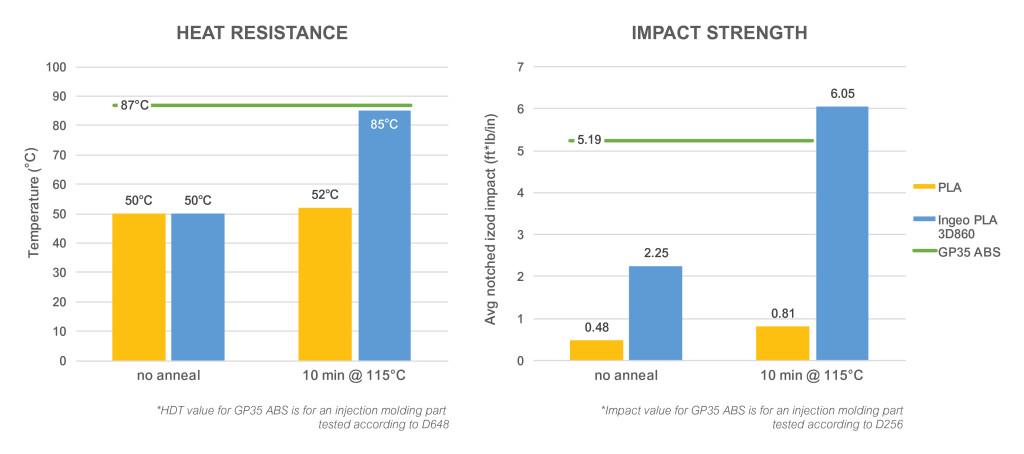
Ingeo 3D860 is an advance version of the popular 3D850 grade of plastic materials that NatureWorks launched in mid-2015 and is a companion material to NatureWorks’ entire line of advanced injection molding and 3D printing filament ABS replacements also released in 2015. The entire line of Ingeo bioplastic materials were developed to offer manufacturers versatile, cost-effective and safe alternatives to styrenic materials. In order to match ABS material, the Ingeo 3D860 PLA-based material simply needs to be exposed to a brief annealing period of about ten to fifteen minutes and temperatures between 212º and 239ºF (100º and 115ºC).
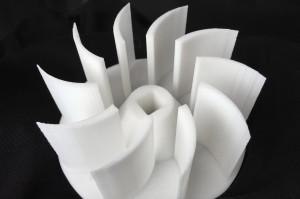
Component 3D printed using Ingeo 3D860.
“Many brands desire a bio-based, low carbon footprint alternative to styrenics. With the addition of Ingeo 3D860, we are providing an option that now enables users to create functional industrial parts or finished goods. We’ve had positive feedback from some industrial users that now view this as a viable alternative to ABS for some of their production jigs and fixtures. 3D860 also allows for rapid prototyping with the ability to approximate the physical properties achievable in injection molded parts made with ABS or with one of our Ingeo durables formulations,” explained NatureWorks Global Leader, New Business Segment, Dan Sawyer.
NatureWorks only recently moved into the 3D printing materials market, but has already heavily invested in their new company endeavor. Their series of Ingeo grade plastics were designed specifically to replace PLA filaments used in the 3D printing market and offer stronger options with less waste and carbon emissions. They have also created a full suite of technical support servicesfor the 3D printing industry’s leading hardware and material manufacturers to help them understand how their products can use Ingeo plastics. They have also open an in-house print lab that allows the company the ability to rapidly test new Ingeo formulations and work closely with printer and filament producers.
 The announcement of the new material was made at Innovation Takes Root 2016, a global biopolymers forum sponsored by NatureWorks. The forum brings together a wide range of representatives from industries at every level of the market chain for plastics and bioplastics. In addition to plastic blend and material suppliers you’ll also find scientists, academics, equipment manufacturers, plastic material distributors, brand owners, material retailers, and media in attendance. The event is being held in Orlando, Florida and will run from March 30th until April 1st. You can find a local supplier or distributor of filaments using Ingeo bioplastics here. What do you think of these new developments in material>? Discuss in the NatureWorks New 3D Printing Filament forum over at 3DPB.com.
The announcement of the new material was made at Innovation Takes Root 2016, a global biopolymers forum sponsored by NatureWorks. The forum brings together a wide range of representatives from industries at every level of the market chain for plastics and bioplastics. In addition to plastic blend and material suppliers you’ll also find scientists, academics, equipment manufacturers, plastic material distributors, brand owners, material retailers, and media in attendance. The event is being held in Orlando, Florida and will run from March 30th until April 1st. You can find a local supplier or distributor of filaments using Ingeo bioplastics here. What do you think of these new developments in material>? Discuss in the NatureWorks New 3D Printing Filament forum over at 3DPB.com.
[“source-3dprint”]

